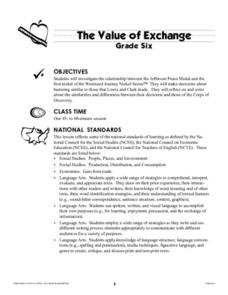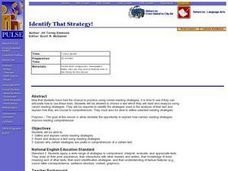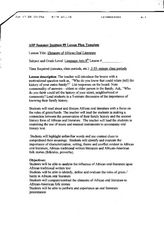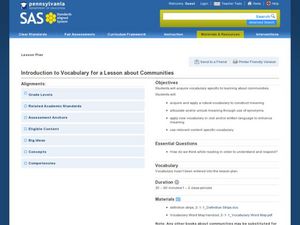Curated OER
Pilgrim for rent lesson plan
Learners are given extensive and intensive reading practice. They review language from the text and give freer speaking practice. Students read an amusing article about an aspect of religion, it should not be used to ridicule pilgrims,...
Curated OER
Skin Cancer Prevention
Students discuss skin cancer prevention. For this skin cancer lesson, students read a pamphlet that tells the causes of skin cancer and what you can do to prevent it. Students will choose from a variety of projects which focus on skin...
Curated OER
Reading the newspaper
Students read articles related to local, state, national, and world events using word maps.
Curated OER
The Value of Exchange
Sixth graders examine the relationship between the Jefferson Peace Medal and the nickels in the Westward Journey Series. They make bartering negotiations to similate the ones made by Lewis and Clark. They note the similarities and...
Curated OER
Identify That Strategy!
Students choose, read,and analyze a text at least one-thousand words long using varied reading strategies. They identify the strategies used in the analysis of their text and explain how they are crucial to comprehension.
Curated OER
Beyond Louisiana
Eleventh graders examine the challenges that faced United States as a new nation. In this American History lesson, 11th graders study the chronology of events leading up to the expedition of Lewis and Clark. Students organize...
Curated OER
Memorable Museums
Second graders describe the impact of certain figures in United States history, including Thomas Jefferson, Meriwether Lewis, and iam Clark. They describe the general features of a community as well as specific features of their own...
Curated OER
Live with Lewis and Clark!
Students list in chronological order the major events in the Corps of Discovery's westward journey. They research goals of the expedition, the make up of the Corps, the modes of travel, the route and the interactions with American Indians.
Curated OER
Language Arts: The Three Appeals
High schoolers are able to identify and describe the persuasive techniques used in editorial writing. They are able to label persuasive techniques with the logos, pathos, and ethos terminology.
Curated OER
Christmas ESL
Students practice speaking and reading in English and are introduced to some vocabulary and traditions connected to Christmas celebrations.
Curated OER
An Amazing Story
Students develop sequential stories to guide a partner through a computer-generated maze. In pairs they illustrate each place and character listed, build and print a maze, and write a class-generated story.
Curated OER
Language Arts: Two Specific Documents
Students are able to read and analyze the essential parts of two specific types of documents, the informed consent document and the position paper, used by scientists to communicate information about their research to two different kinds...
Curated OER
Creative Problem Solving: Using the 5 W's (Who, What, Where, When, Why)
Third graders assimilate the use of the 5 W's (Who, What, Where, When, Why) when solving problems that are presented in literature and in real life situations. They use common fairy tales to solve problems that might arise at home or...
Curated OER
Virginia Woolf: A Room of One's Own - Shakespeare's Sister
Students, after reading and analyzing, "A Room of One's Own," by Virginia Woolf, analyze how creating and defending one's position as well as how narrative functions as a rhetorical device. They evaluate and focus in on Shakespeare's...
Curated OER
Elements of African Oral Literature
Ninth graders examine the importance of family history. In this Language Arts activity, 9th graders read and discuss African oral literature with a focus on the roles of griots. Students compare /contrast the elements of African oral...
Curated OER
Katie Kangaroo's Leap of Courage
Students are introduced to the concept of courage. As a class, they read a book about Katie Kangaroo and her leap of courage and discuss how they can be couragous in their own life. They complete a worksheet and share their responses...
Curated OER
Science Happens in a Social Context
Students discuss how the same data is viewed differently between historians and scientists. Using the data, they compare and contrast the vocabulary used and the focus of attention. They analyze the conditions that help spread diseases...
Curated OER
Those Cells Look Good Enough to Eat
Students explore the parts of the cell. In this cell lesson, students use foods to create cell models that represent the nucleus, cytoplasm, cell membrane, mitochondria, ribosomes, vacuoles, endoplasmic reticulum, and Golgi bodies...
Curated OER
Introducation to Vocabulary for a Lesson about Communities
Students practice using new vocabulary they learn about communities. In this communities vocabulary lesson plan, students use synonyms, context clues, and relevant content to unlock the meaning of new vocabulary words.
Alabama Learning Exchange
As Large As Life. . . A Poster of a Human Body System
Learners explore the major systems and functions of the human body. In this anatomy lesson, students make life-size outlines of bodies, diagram body systems, and present their work to their classmates.
Curated OER
Listening for Tone
Students read and listen to various poems as they are read by different readers using different tones. They read "Jabberwocky" and in groups, determine what they think the nonsense words in the poem mean. The groups compare thier ideas...
Curated OER
Prefix-Suffix Rummy
Students correctly build new words by adding a prefix and/or suffix to existing base words.
Curated OER
What Do You Call Older People?
Students brainstorm a list of words they use to refer to the elderly. As a class, they discuss the importance of word connotations and explain those used to refer to the older population. They complete a handout and share their thoughts...
Curated OER
Making Sense with Amelia Bedelia
Students listen to a read aloud of Peggy Parish's. Teach Us Amelia Bedelia and make a list of all of the phrases she misunderstood. They rewrite the directions for easier comprehension.

























